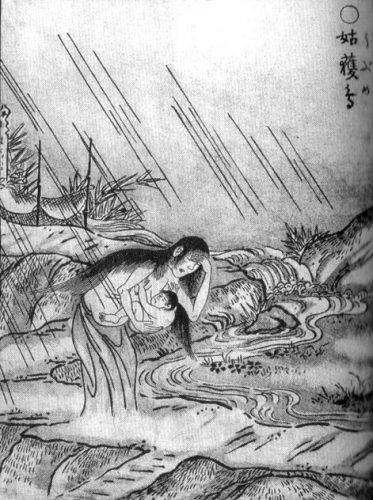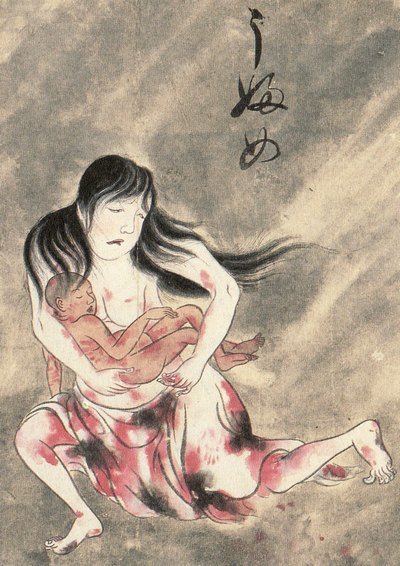Date of Discovery
Found as far back as the Heian-period Tales of Times Now Past, the first known date of her being described was during the Edo period, in 1687. Through the illustrations in the picture scrolls of the Hyakkai-zukan and the Bakemono zukushi within Toriyama Sekien’s catalog, Ubume’s image as a yokai became permanent.
Name
The Ubume is also known as the Birthing Woman. She has many different names across the many regions of Japan–in the Shiga Prefecture, she is known as the Ubume-tori and on Sado Island in the Niigata Prefecture, she is known as the Ubu–other names include Obo, Unme, Ugume, and Ubame tori.
In modern times, the standard kanji characters used to name her literally define how she died, 産女, which translates to “birthing woman.”
Since death during childbirth was such a common experience before modern medicine, it’s possible that the Ubume is related to a similar yokai, known as the kosodate-yurei, which translates to “child-rearing ghost.”
Physical Description
The Ubume can appear in many different forms, many of the most popular renditions are when she appears as a woman carrying a baby, a pregnant woman, or a blood-soaked walking corpse carrying an underdeveloped fetus. At times her apparition can be described as a bloody pregnant woman who cries out into the night in desperate need for help; all of these variations are because of the different burial traditions in the different regions from which the story originates, as well as the circumstances under which the woman and her child died. Within the traditions of burying a woman who died while trying to birth a stillborn fetus, she would either be buried with the baby within her womb, or they would cut the child out of her and cradle the fetus in her arms for burial.
Origin
The origin of the Ubume is the result of a woman who dies just before, during, or shortly after childbirth, where the spirit experiences crippling anxiety about the safety of her child after passing. Due to this unresolved issue, her ghost manifests as the Ubume and her spirit will typically appear later on during dark and rainy nights.
The Ubume embodies the serious health concerns about pregnancy and safely delivering a child. She represents the self-sacrificing spirit of motherhood. Several Buddhist temples in Japan, are actually associated with the Ubume, motherhood, as well as the act of childbirth itself.
Mythology and Lore
According to The Book of Yokai: Mysterious Creatures of Japanese Folklore by Michael Dylan Foster, the Ubume is found in various different forms throughout the country of Japan and resides in a collection of ghost stories, religious texts, and other documents. The details of her stories vary from place to place, but she is commonly thought of as the apparition of a woman who died during childbirth.
In one version of the tale, she will appear at crossroads or upon a bridge as twilight falls upon the region, with her lower body completely soaked in blood, she appears to be crying and cradling an infant in her arms. If a male passes her by, she asks him to hold the baby, and then promptly leaves. In this version, the baby continuously grows heavier in the man’s arms until he cannot move or risk dropping the child–in alternatives of this particular tale, the baby actually turns into a stone.
Although it’s never clear what happens to the baby or the woman, there are always different outcomes to each narrative depending upon the region from which the tale originates. One in particular ends with the man being rewarded for his effort with the gift of physical strength, which he is able to pass on to his descendants in the years to come.
In many other parts of Japan, there is a legend of a mysterious woman who comes night after night to buy candy from a corner store. One night, after the shopkeeper has grown suspicious of her, he follows her and finds that she disappears into a graveyard. As soon as she disappears, he hears a baby crying and stumbles upon a grave that has been dug up, where a woman who had died during childbirth had recently been buried. The strangest thing happens when he finds this grave, he finds her baby, healthy and alive laying by the side of the freshly decomposing corpse of its mother. The shopkeeper takes the child in, and in many legends, the baby grows up to become a prominent Buddhist monk.
Within the Night Parade of One Hundred Demons: A Field Guide to Japanese Yokai, the author Matthew Meyer discusses how these tragic spirits wander the areas near where they passed away, where the baby survives, and her attempts to care for the child that she left behind. In some cases, she even attempts to purchase food, clothes, or candy for her surviving child, but in place of money, she tries to purchase it with handfuls of dead leaves. This particular Ubume is also known to try to lead someone to where her baby is hidden so it can be cared for by the living.
Modern Pop-Culture References
The Ubume became a well-known fictional character within popular Japanese culture, by means of Kabuki dramas, where she was the basis for the ghost of Oiwa-san, a vengeful spirit who returns from the dead to haunt her cruel and cheating husband within the play Tokaido-Yotsuya Kaidan from 1825. Surprisingly, this doesn’t sound all too unfamiliar with ghost stories such as the one of La Llorona.
Is there anything we missed about the Ubume? Let us know in the comments section below!

Georgia-based author and artist, Mary has been a horror aficionado since the mid-2000s. Originally a hobby artist and writer, she found her niche in the horror industry in late 2019 and hasn’t looked back since. Mary’s evolution into a horror expert allowed her to express herself truly for the first time in her life. Now, she prides herself on indulging in the stuff of nightmares.
Mary also moonlights as a content creator across multiple social media platforms—breaking down horror tropes on YouTube, as well as playing horror games and broadcasting live digital art sessions on Twitch.


